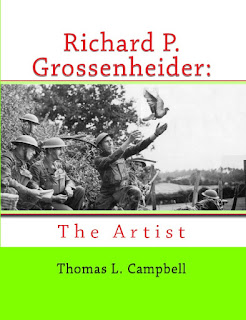Capturing Wildlife
With a Brush Weaved into New Children’s Biography
St. Louis, Missouri (02/30/2017) –Richard P. Grossenheider:
The Artist by Thomas L. Campbell and Katherine Hattieann Manning is an easy
reader biography of a fascinating artist in American history. The book contains
a treasure trove of primary documents including photographs, facsimiles of
letters, newspaper clippings, and original drawings. Like many traditional biographies,
the narration begins with the context of Grossenheider’s family and the story
of how his grandfather came to America in the early 1800s. The authors then
trace his story through his father, who was a distinguished artisan, and
through Richard’s childhood and studies in biology in college, which led to his
career as a naturalist and artist. The simple text is appropriate for young
readers, and the book would make an interesting book report for students
assigned a biography.
Though Richard P. Grossenheider is not well-known, his life
contains dozens of interesting details from his experiences during World War II
and his work illustrating wildlife. Campbell and Manning draw lessons from his
life, including the concept that every individual makes a difference and has a
role to play. Grossenheider had an unusual career path as an artist because his
interest in wildlife led to an important service with developing homing pigeons
during World War II. His story shows how gifts might be used in unexpected ways.
The real strength of Richard P. Grossenheider: The Artist by
Thomas L. Campbell and Katherine Hattieann Manning is as an example of primary
documents for young historians, who will benefit from learning how photographs,
newspaper clippings, and letters can help us learn about the past and the
people who made a difference. An interesting book for young historians!
“Richard P. Grossenheider: The Artist” will be available for
sale in bookstores, online at Amazon.com and other channels.
About the Author:
Thomas L. Campbell lives in St. Louis, where he found
inspiration for new stories. Growing up knowing that his ancestors were denied
the right to read made Thomas intrigued by books, and at an early age, he
started dreaming of becoming a published author. Born to a poor, single-mother
and attending schools where a student with hope of getting an education had to first
survive living in war zones in their own homes and communities, Thomas’ goal of
being a writer was like reaching for the stars. Thomas spent decades writing
urban fiction before he learned truth has the power to heal. After receiving
realms of rejections from publishing companies, Thomas realized he was blind to
his true calling to inspire children by writing biographies.

 Richard P.
Grossenheider: The Artist by Thomas L. Campbell and Katherine Hattieann
Manning is an easy reader biography of a fascinating artist in American
history. The book contains a treasure trove of primary documents including
photographs, facsimiles of letters, newspaper clippings, and original drawings.
Like many traditional biographies, the narration begins with the context of
Grossenheider’s family and the story of how his grandfather came to America in
the early 1800s. The authors then trace his story through his father, who was a
distinguished artisan, and through Richard’s childhood and studies in biology
in college, which led to his career as a naturalist and artist. The simple text
is appropriate for young readers, and the book would make an interesting book
report for students assigned a biography.
Richard P.
Grossenheider: The Artist by Thomas L. Campbell and Katherine Hattieann
Manning is an easy reader biography of a fascinating artist in American
history. The book contains a treasure trove of primary documents including
photographs, facsimiles of letters, newspaper clippings, and original drawings.
Like many traditional biographies, the narration begins with the context of
Grossenheider’s family and the story of how his grandfather came to America in
the early 1800s. The authors then trace his story through his father, who was a
distinguished artisan, and through Richard’s childhood and studies in biology
in college, which led to his career as a naturalist and artist. The simple text
is appropriate for young readers, and the book would make an interesting book
report for students assigned a biography.





